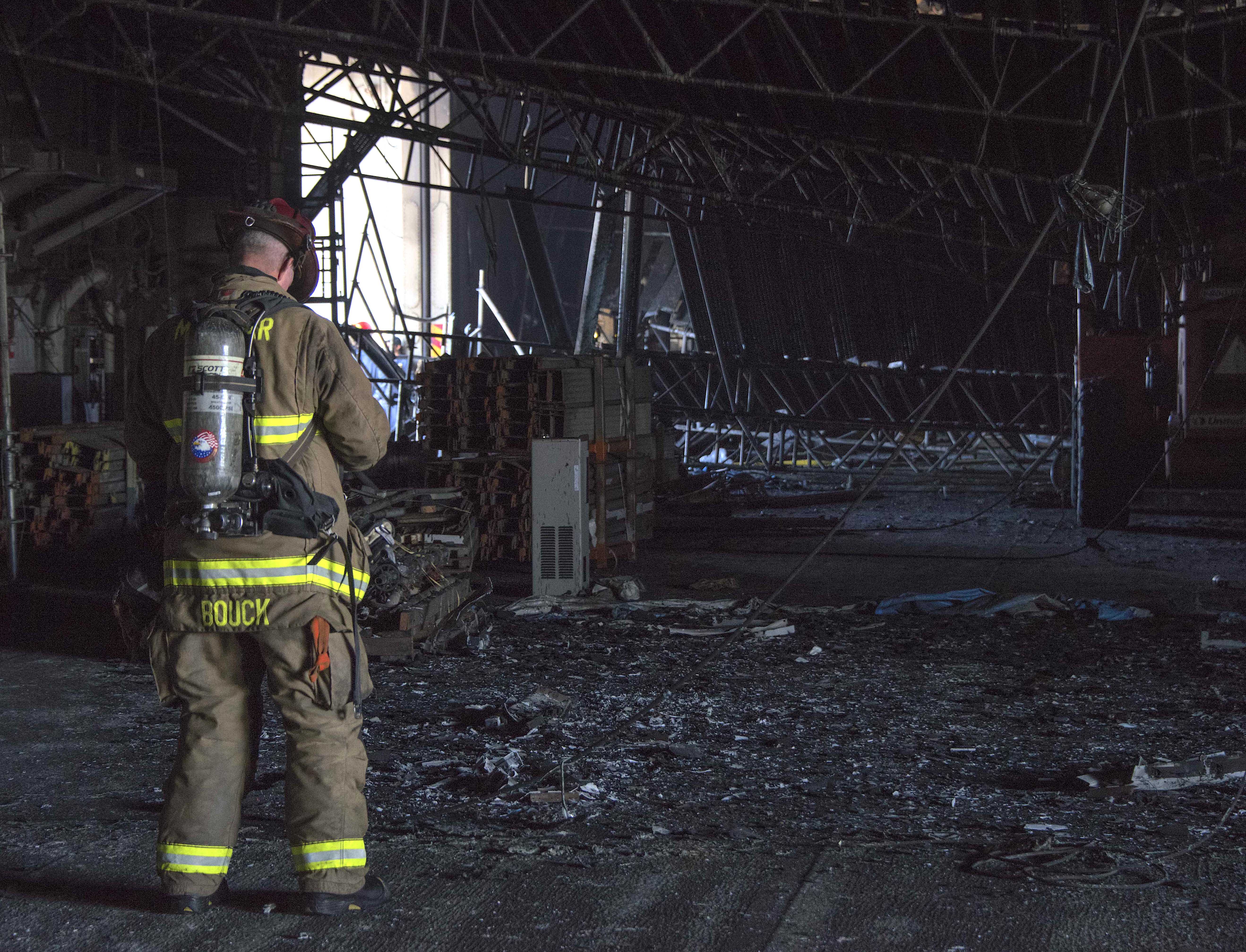
SAN DIEGO, Calif. – On midday Thursday, Navy officials declared all known fires aboard USS Bonhomme Richard (LHD-6) had been extinguished after more than four days of battling the blaze that was sparked on Sunday.
“Now that things are starting to cool off, we can go and actually assess… what the real issues are,” Rear Admiral Philip Sobeck, the commander of Expeditionary Strike Group 3, told reporters on Thursday at Naval Base San Diego. Crews were going “space by space,” as areas cooled to check for hot spots.
“It’s in stable condition, all the way through,” Sobeck said. “The deck underneath is secure, so there’s no issue… The ship can be repaired.”
On Thursday afternoon, just a little smoke emanated from Bonhomme Richard as sailors worked to stabilize the ship after the fire. The hundreds of thousands of gallons of water pumped to fight the blazes caused the ship to list to starboard and then to port, Sobeck said. He added that dewatering work was helping keep the ship stable.
Explosions disrupt initial attacks
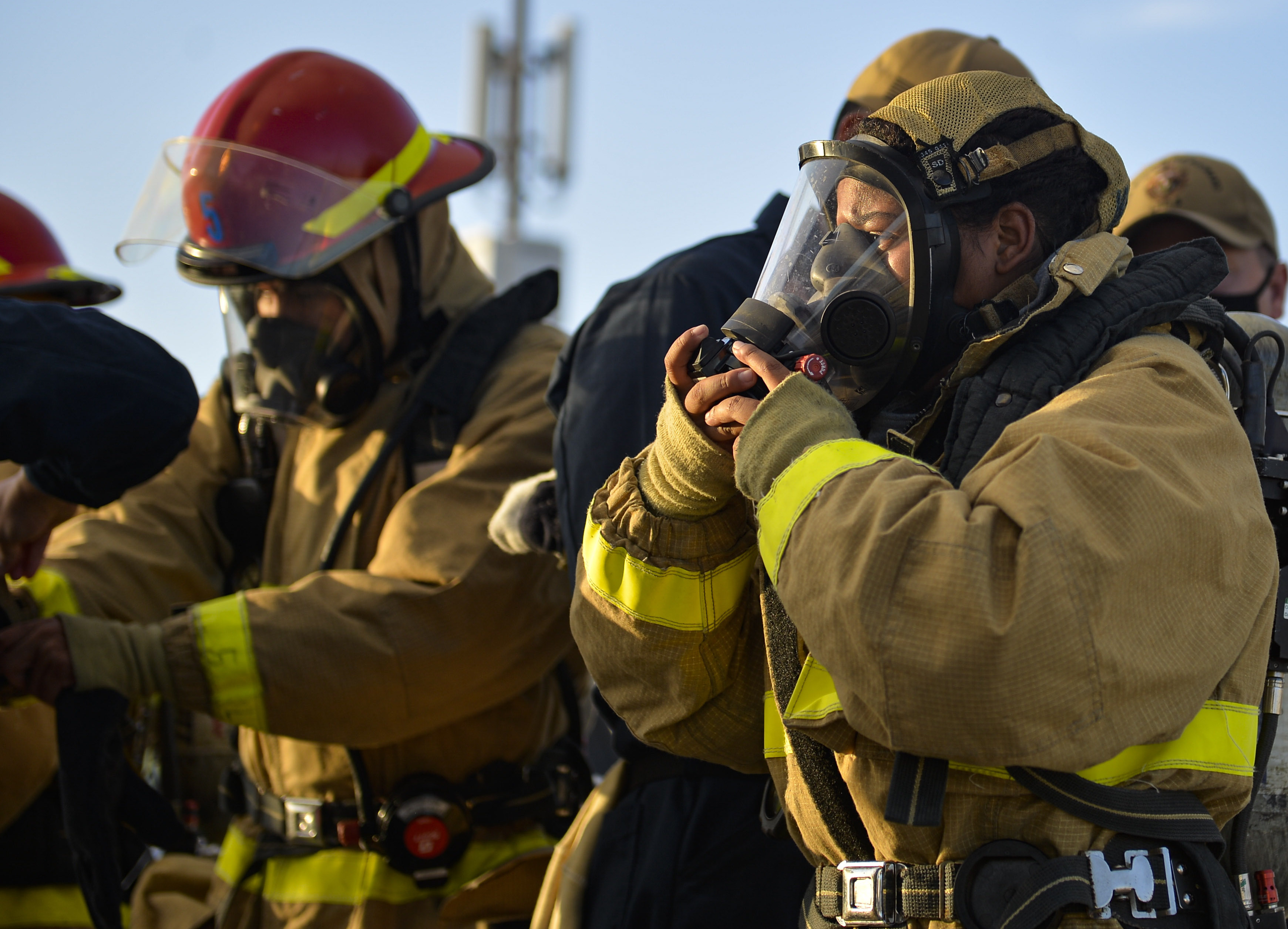
On Sunday, scores of firefighters and equipment responded to the three-alarm blaze and began to descend on Pier 2. They came to support the sailors fighting the blaze on Bonhomme Richard that initial reports say started in the lower vehicle deck in the aft portion of the ship.
Responding to a 911 call, crews from the on-base San Diego Federal Fire Department found thick clouds of black and smoke pouring out of the hull as the small company of 160 sailors on the ship fought through the smoky interior.
Federal Fire took command of the scene and was moving to support the sailors in the ship when an explosion changed the course of the fire, Federal Fire Chief Mary Anderson told USNI News on Thursday.
“They were knocked to the ground… [The blast] blew some of the helmets off, their masks off,” she said. “After the explosion, we moved off [the pier]. At that point, we realized that we were going to have a major firefight.”
Following the explosion, the ship’s company abandoned an effort to activate the ship’s internal fire systems that had been turned off during the maintenance period. It was almost a half-hour after the explosion before it was safe enough to put fire crews back aboard, Anderson said.
“After the explosion, we knew it was spreading, because it had to go somewhere,” she said of the fire. “When we retreated, we actually saw smoke come out of a different part [of the ship].”
Smoke was pouring from the ship as the local battalion chief pulled up with two SDFFD engines to the scene. The second alarm was called, bringing other fire assets from area naval bases and requests for mutual aid, and soon after, the third alarm sounded to draw city fire departments to help, as well as contracted rescue medical ambulances.”
Federal fire personnel came from Navy and Marine Corps bases across Navy Region Southwest, as just over 200 personnel and 14 fire engines responded.
Two other ships shared Pier 2 – Burke-class destroyers, USS Russell (DDG-59) and USS Fitzgerald (DDG-62) – and posed a problem. “We needed to clear them off,” she said. Both ships’ crews sheltered in place before both vessels pulled away and relocated to another pier about five hours after the fire began.
For the first two days, heavy smoke and flames enveloped Bonhomme Richard, making it hard for the firefighters to assess the condition of the ship from the pier.
“Our biggest concern, especially on the ground, was the superstructure,” Anderson said. “If that were to fall, it wouldn’t give us enough warning to clear. But a helicopter up there could see what was happening with that superstructure, and that’s why we were able to remain on the pier the whole time because we had the safety recon and the safety intel about what was going on.”
Federal Fire also coordinated with ship engineers, Naval Sea Systems Command personnel and the Bonhomme Richard’s crew, “because they know the ship like the back of their hand. The dangers. The hazards. What’s where,” she said. Each hose team had two sailors and two firefighters working together.
Inside the ship, collapsed aluminum scaffolding created slowed down fire crews moving through spaces and managing fire hoses. Crews had to make paths through the jumble of metal to clear access to bring hoses into the interior of the ship.
Outside, MH-60S helicopters from the “Merlins” of Helicopter Sea Combat Squadron 3, fireboats and tugs dumped water into exposed interior spaces to cool the hull.
Initial support on the water came from San Diego Harbor Police fireboats later joined by Navy port operations’ tugs and NAVSEA tugs from Long Beach. The boats doused the starboard side of the ship. One of the large tugs “acted like a giant fire hydrant for us,” Anderson said, pulling seawater and sending it to the pier.
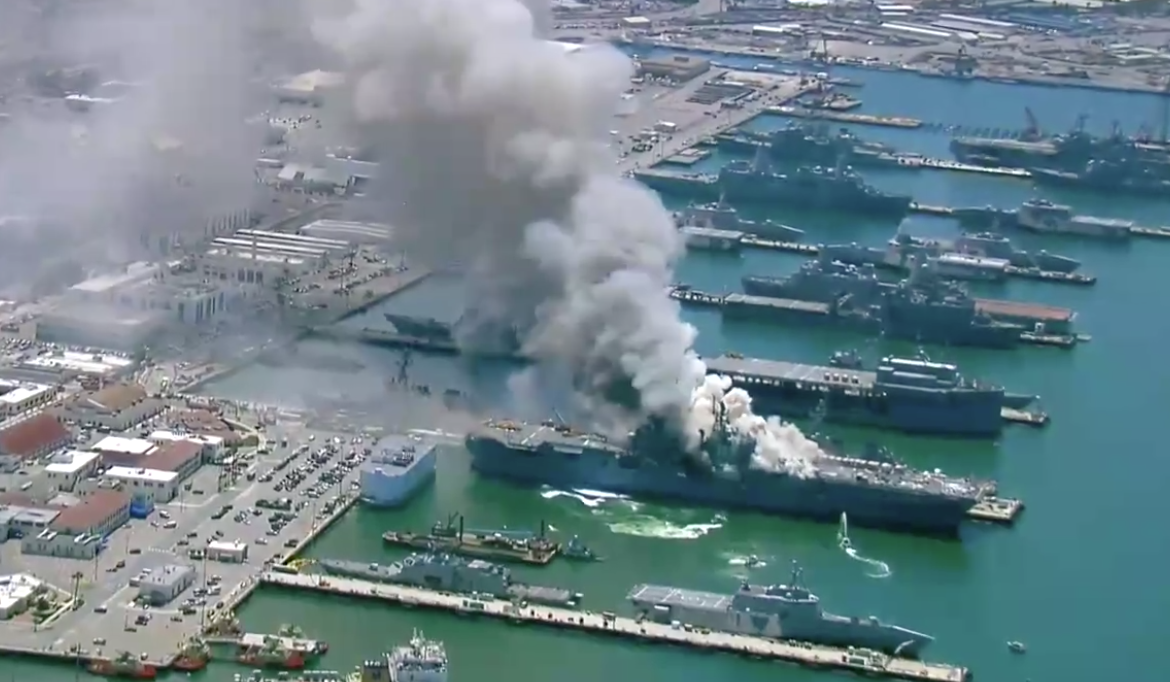
An early concern was that the fire could threaten the one million gallons of fuel in the ship’s tanks. The amount of fuel onboard was necessary because “they had to start testing their engines and everything else,” Sobeck said. “For that size of a ship, a million gallons is not that much fuel.”
However, by Tuesday firefighters were able to create a buffer from the active blazes and the fuel stores.
Key to the overall fire strategy was the awareness the helicopters provided to the command. The pilots and crews relayed details of the fire’s progress from the air during the water drops over the ship. The helicopters heat-detecting FLIR sensors helped find hot spots inside the ship.
“We still use it today to let us know temperature readings so we coordinate our firefighting efforts,” Anderson said.

The cooling efforts from boats and helicopters, along with opening up walls and external hull in places, helped reduce the interior aluminum-melting, 1,200-degree heat to a more manageable 125 degrees. That enabled damage-control teams and others to inspect spaces and assess damage to help officials determine what’s next in clearing out, restoration and salvage.
No one was seriously hurt in the initial fires and firefighting response, officials said. By Thursday, medical teams treated 40 sailors and 23 civilians for minor injuries, including heat exhaustion and smoke inhalation. Among the injured were four of Anderson’s federal firefighters, one who suffered a fractured hand.
“Everyone has been released and are in good spirits,” she said.
Maintenance period
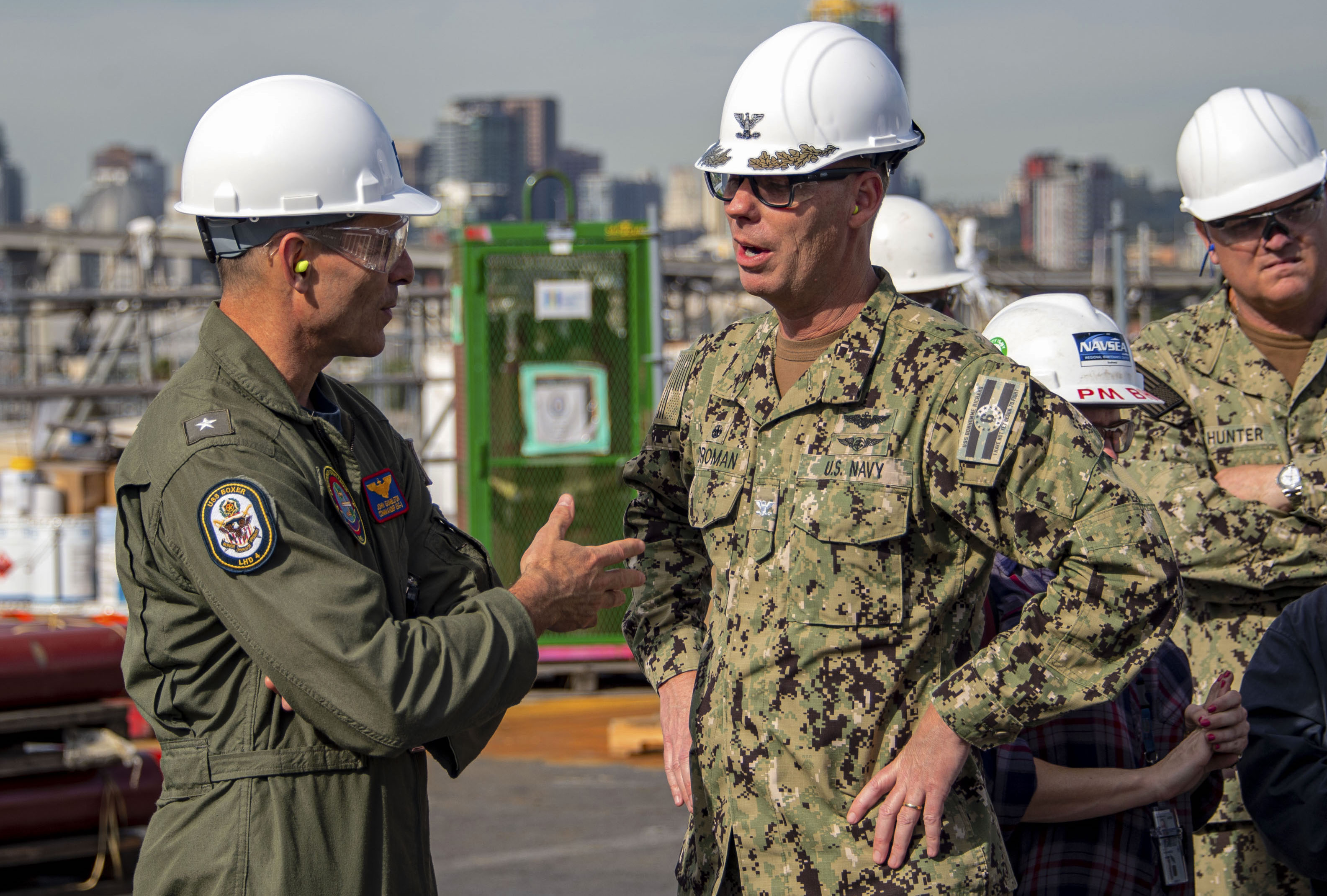
Bonhomme Richard was about two-thirds through the maintenance that had to be completed before the ship could return to basic training, Sobeck said.
“She was almost done with most of the maintenance, that’s why things were starting to come back onboard the ship and starting to be put back together again,” he said.
The $249 million availability began in late 2018 and included time in the drydock at the nearby General Dynamics NASSCO shipyard, where the ship got upgrades to embark the Marine Corps’ F-35B Lightning II Joint Strike Fighter.
“They were just getting ready to move back on and establish more of a footprint on the ship… they were sort of in a transition point where they were moving stores on and moving their personal stuff,” he said.
About 85 sailors were living aboard the ship when the fire broke out, base commander Capt. Mark Nieswiadomy told reporters. They’ve been relocated to barracks in San Diego and nearby Point Loma Naval Base. Local community efforts, including the USO, have been providing them with basic necessities including clothing.
Sobeck said Thursday that Bonhomme Richard’s commander Capt. G. Scott Thoromanthe and the rest of the ship’s leadership “remain on station” and are supporting firefighting efforts.
What’s next
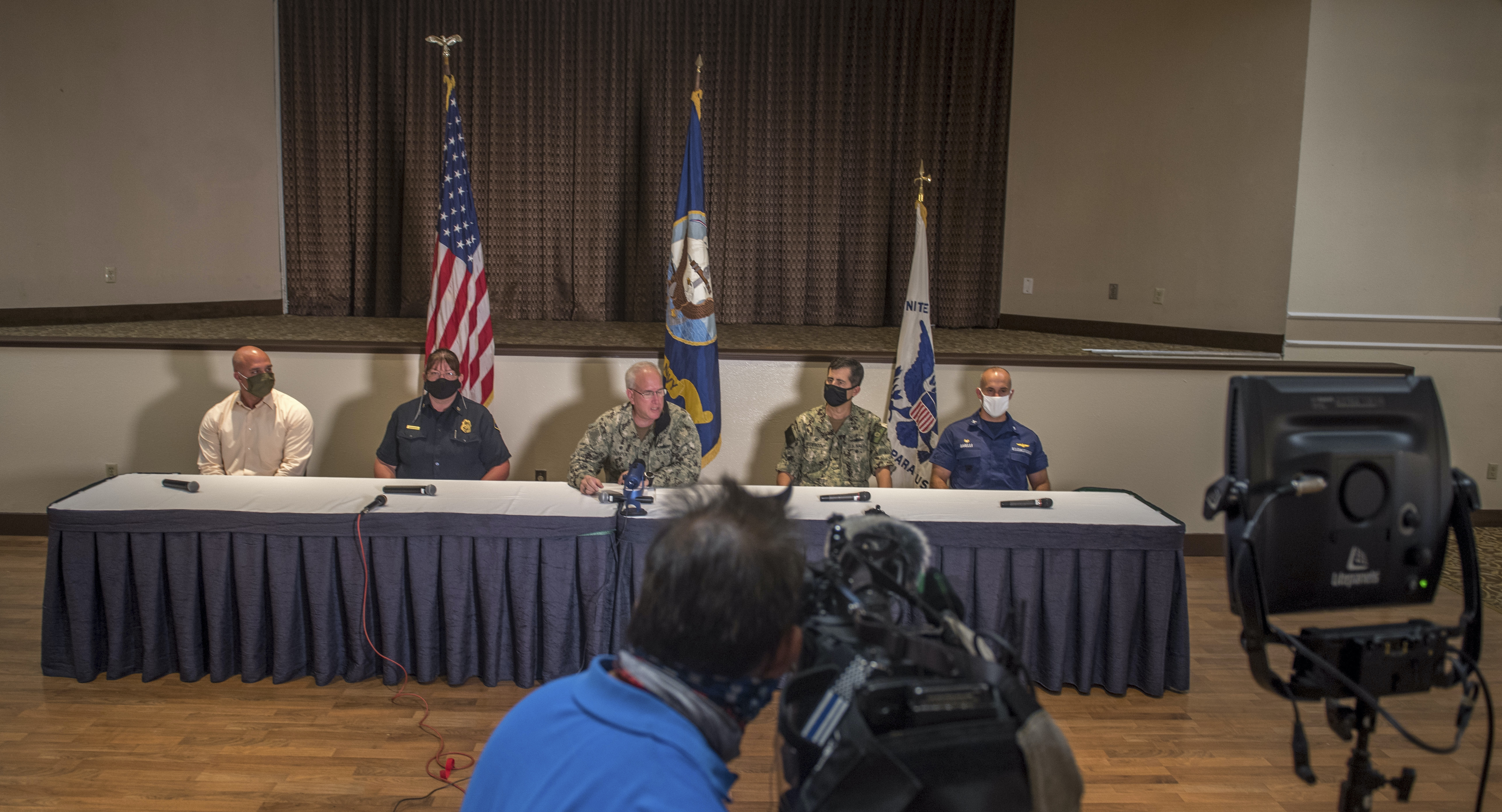
With the bulk of the firefighting complete, the investigation into what happened can begin earnest.
The Naval Safety Center will conduct the safety investigation, with Naval Sea Systems Command involved. Adm. John Aquilino, commander of U.S. Pacific Fleet, “will then have the overall investigation,” Sobeck said.
“The timeline is as long as it takes,” he said, noting, “there will be multiple levels of investigation.”
The probes will start as temperatures down enough for teams to get into spaces and compartments safely and ensure no embers remain.
“That’s a long process reaching each and every space,” he said.
The main deck “and above” is where most of the damage was,” Sobeck said, starting from the “lower V” area where Marine vehicles and equipment are stowed, and spreading up as the fire expanded.
Chief of Naval Operations Adm. Mike Gilday heads to San Diego on Friday to evaluate the damage. New NAVSEA commander Vice Adm. Bill Galinis is also in San Diego, USNI News has learned.





